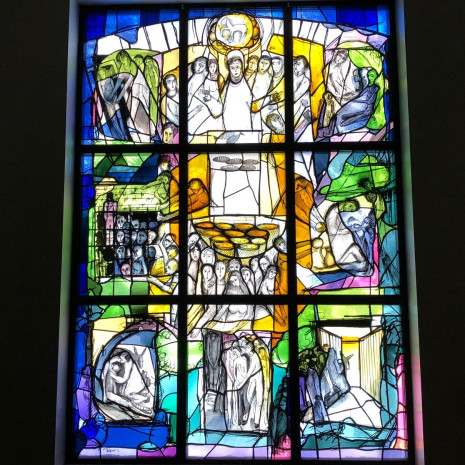
Windows near chapel: corporal works of mercy
Installed at Holy Child Parish in August 1992
These scriptural prayer windows were designed by Egon Stratmann, a well-known liturgical artist for the diocese of Essen, Germany.
The process used in making these windows in Paderborn, Germany has not changed in nearly 700 years. The design is put onto heavy paper. Each piece is cut out, placed on coloured glass and cut with a diamond cutter. The detail designs (lamb, people, etc.) are then painted on the coloured glass. Each piece is baked, assembled into lead channeling which in turn is soldered together to complete the window.
“Whatsoever you do to the least of my brothers and sisters, you do it to me.” (Matthew 25:40)
In the second window, the two upper centre panels foreshadow the Last Supper, the Eucharist. In Matthew 14:13-21 we have the multiplication of the loaves and fish. Jesus asked the disciples to feed the gathering. We too are called to be Eucharist to each other. The person in the upper centre could be Christ or any member of the community in and through whom Christ works. The twelve baskets that were left over (centre panel) remind us that Christ with so little can do so much. So often we feel inadequate but if we let Christ be with us we may be surprised.
The Medallion — symbolizing the Lamb of God — is the symbol of the Eucharist, which brings us back and constantly reminds us of the death and resurrection of Christ—the source of strength for the parish community.
Eucharist calls us to respond to the seven Corporal Works of Mercy —Matthew 25-31:16 and Tobias 1:17.
1. In the upper right panel the community shares bread with the hungry. The community not only responds to physical hunger but also to the hunger for knowledge and truth, thus the book in the hand with bread. Jesus in the desert also said, "People do not live on bread alone but also on the Word of God."
2. In the centre right panel the community responds by giving drink to the thirsty — Christ from the cross also cried, "I thirst."
3. The lower right panel depicts strangers, those having to flee their homeland and, newcomers are drawn to the golden light of hospitality —Mary and child on the donkey left for Egypt as strangers as well.
4. In the lower centre panel we are called to clothe the naked. Christ was also stripped of His clothing on His way to Calvary. We see ourselves clothing Christ and the naked.
5. The lower left panel is our call to help and visit the sick. Jesus taught this with the parable of the Good Samaritan. The priest and Levite who walked away are depicted.
6. In the centre left panel we see the imprisoned behind bars and barbed wire. We are called to tear open the bars and cut the wire of those imprisoned because of injustice, addictions, lack of education and lack of freedom. We also see Christ the prisoner tied to the pillar.
7. In the upper left panel — bury the dead—we also remember the passion, "Jesus was placed in the grave."
Mass Schedule
| Tue | 8:30am |
| Wed | 8:30am |
| Thu | 8:30am |
| Fri | 8:30am |
| Sat | 7:00pm |
| Sun | 10:00am |
| Mon | No Mass |